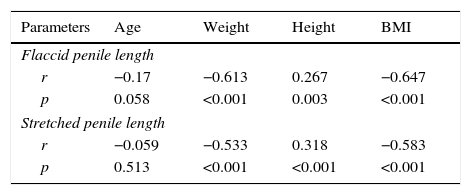The aim of the present study was to assess the relationship between penile length and somatometric parameters, especially cachexia.
Material and methodsWeight and heights of all patients were measured and recorded by an internal medicine specialist. Flaccid and stretched states of penis were measured from pubic bone to tip of glans along the dorsum of the penis using a rigid metric ruler by a single urology specialist. Patients with urogenital abnormalities were excluded from the study. Penile length, age, weight and height values were recorded. Body mass index (BMI) was computed as the ratio of weight to the square of height. Patients were divided into three groups according to BMI cachexia, normal weight and obesity. Groups were defined: Group 1: Cachexia, BMI<18.5; Group 2: normal weight BMI, between 18.5 and 25; Group 3: obesity, BMI>30. Mean and median penile lengths were calculated. These three groups were evaluated in terms of whether there is a difference between flaccid and stretched penile length. Also correlation between weight, height and penile length was determined.
Statistical analyses were performed using the SPSS for windows ver. 16.0 (SPSS Inc., Chicago, IL, USA). Statistical significance was set at p<0.05.
ResultsOne hundred and twenty four patients enrolled in the study. Fourteen patients were in the cachectic group. Fifty six patients were in the normal weight group. Fifty four patients were in the obese group. Both flaccid and stretched penile lengths were statistically different in these groups (p<0.001; p<0.001). When we compared the groups separately, cachectic group's penile lengths were significantly longer than the normal weight group at both (p<0.01; p=0.02). Cachectic group's penile lengths were significantly longer than the obese group (p<0.001; p<0.001). Also normal weight group's penile lengths were longer than those of the obese group (p<0.001; p<0.001).
ConclusionThe present study is the first one assessing the relationship between cachexia and penile length. As a result, cachexia may be an advantage for penile length.
El objetivo del presente estudio fue evaluar la relación entre la longitud del pene y los parámetros somatométricos, especialmente la caquexia.
Materiales y métodosEl peso y la altura de todos los pacientes fueron medidos y registrados por un especialista en medicina interna. Los estados flácidos y estirados del pene se midieron a partir del hueso púbico hasta la punta del glande a lo largo del dorso del pene, utilizando una regla métrica rígida, por un único especialista en urología. Los pacientes con anormalidades urogenitales fueron excluidos del estudio. Se registraron la longitud del pene, la edad, el peso y las alturas. El índice de masa corporal (IMC) se calcula como el cociente entre el peso y el cuadrado de la altura. Los pacientes fueron divididos en 3 grupos según el IMC: caquexia, peso normal y obesidad. Se definieron los grupos: Grupo 1: caquexia, IMC<18,5; Grupo 2: peso normal, IMC entre 18,5 y 25, y Grupo 3: obesidad, IMC>30. Se calcularon las longitudes del pene media y mediana. Estos 3 grupos fueron evaluados en términos de si había diferencia entre la longitud del pene flácido y estirado. También se determinó la correlación entre el peso, la altura y la longitud del pene.
Los análisis estadísticos se realizaron con el programa SPSS® para Windows ver. 16.0 (SPSS Inc., Chicago, IL, EE.UU.). La significación estadística se estableció en p<0,05.
ResultadosCiento veinticuatro pacientes fueron incluidos en el estudio. Catorce pacientes estaban en el grupo de la caquexia. Cincuenta y seis pacientes estaban en el grupo de peso normal. Cincuenta y cuatro pacientes estaban en el grupo obeso. Ambas longitudes del pene flácido y estiradas fueron estadísticamente diferentes en estos grupos (p<0,001; p<0,001). Cuando se compararon las longitudes del pene por separado, las del grupo caquéctico fueron significativamente mayores que las del grupo de peso normal en ambos (p<0,01; p=0,02). Las longitudes del pene del grupo caquéctico fueron significativamente más largas que las del grupo de obesos (p<0,001; p<0,001). También la longitud del pene del grupo de peso normal era mayor que la del grupo de obesos (p<0,001; p<0,001).
ConclusiónEl presente estudio es el primero en evaluar la relación entre la caquexia y la longitud del pene. Como resultado, la caquexia puede ser una ventaja para la longitud del pene.








